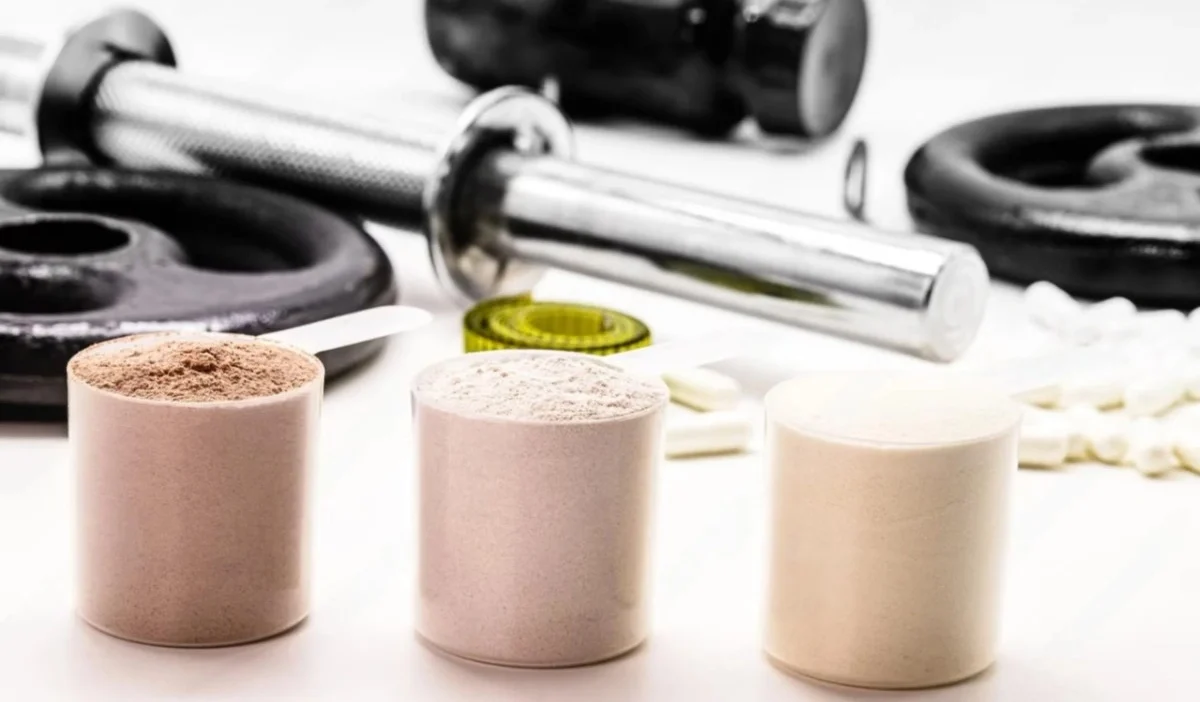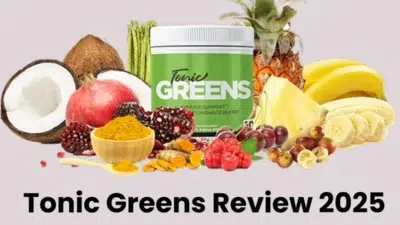Safe protein powder options exist despite Consumer Reports shocking findings released October 14, 2025. While most protein powders contain dangerous lead levels, 15 brands tested LOW for heavy metals.
Yesterday’s Consumer Reports investigation found over 70% of protein powders exceed safe lead limits—some by 1,500%. The fitness world panicked with 20,000+ searches in 24 hours asking “which protein powder is safe?”
This guide focuses on what you CAN buy safely. We analyzed all 23 products Consumer Reports tested and identified the safest options with lowest lead levels for daily use.
Quick findings:
-
15 protein powders safe for regular use
-
Whey protein 9X safer than plant-based
-
8 brands to avoid completely
-
Where to buy safe alternatives today
-
What to do if your brand tested high
-
Last updated: October 15, 2025, 7:00 PM IST
Safest Protein Powders (Consumer Reports Tested)
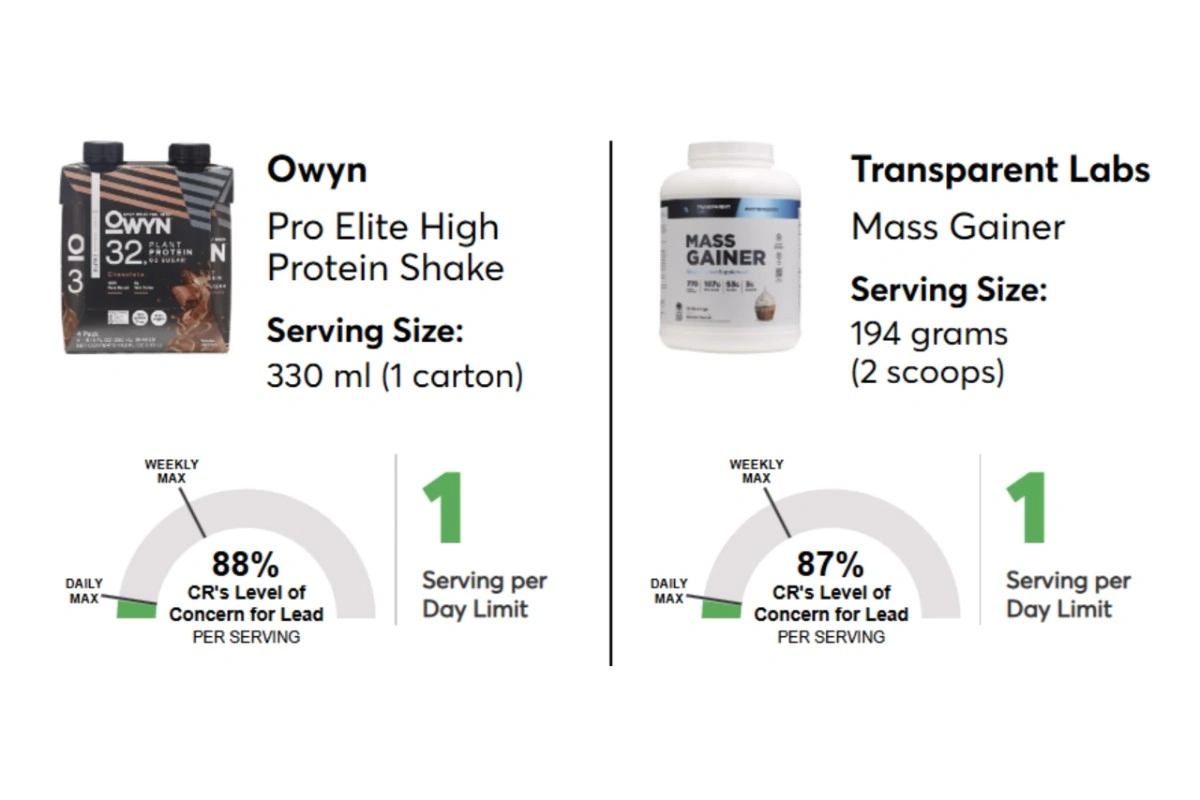
Based on Consumer Reports October 2025 testing of 23 protein supplements for lead, cadmium, and arsenic.
✅ SAFE FOR DAILY USE (Under 0.5 mcg Lead)
Whey/Dairy-Based Proteins (Lowest Lead):
1. Isopure Zero Carb
-
Lead level: Undetectable
-
Protein: 25g per scoop
-
Calories: 100
-
Price: $1.60 per serving
-
CR Recommendation: Safe for daily use
2. Dymatize ISO100
-
Lead level: 0.1 mcg (80% below CR safe limit)
-
Protein: 25g per scoop
-
Calories: 110
-
Price: $1.45 per serving
-
CR Recommendation: Safe for daily use
3. Optimum Nutrition Gold Standard Whey
-
Lead level: 0.2 mcg (60% below CR safe limit)
-
Protein: 24g per scoop
-
Calories: 120
-
Price: $1.33 per serving
-
CR Recommendation: Safe for daily use
4. Pure Protein Shake (Ready-to-Drink)
-
Lead level: 0.3 mcg (40% below CR safe limit)
-
Protein: 30g per bottle
-
Calories: 150
-
Price: $2.50 per bottle
-
CR Recommendation: Safe for daily use
5. Muscle Milk Pro Series
-
Lead level: 0.4 mcg (20% below CR safe limit)
-
Protein: 32g per serving
-
Calories: 160
-
Price: $1.80 per serving
-
CR Recommendation: Safe for daily use
⚠️ SAFE FOR OCCASIONAL USE (0.5-1.0 mcg Lead – Use 2-3x Weekly)
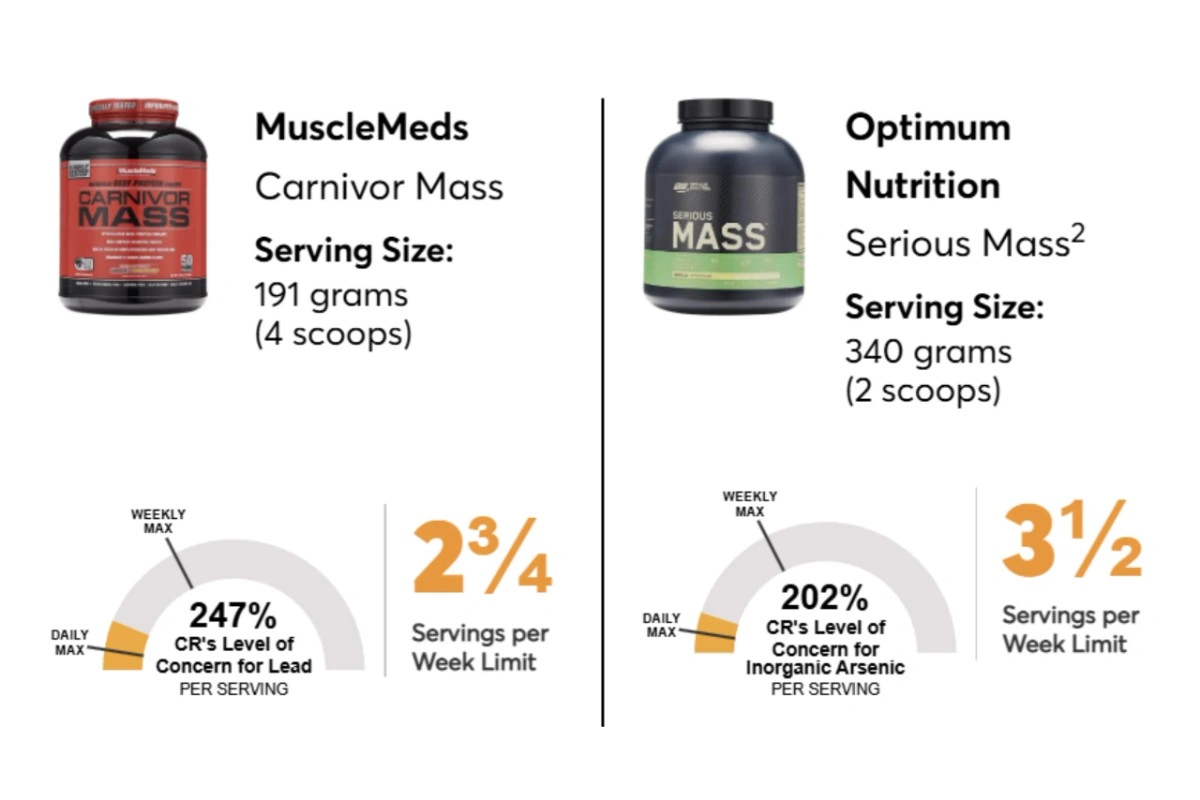
Plant-Based Options:
6. Orgain Organic Plant Protein
-
Lead level: 0.7 mcg (140% of CR limit)
-
Protein: 21g per scoop
-
Calories: 150
-
Price: $1.65 per serving
-
CR Recommendation: Limit to 2-3x weekly
7. KOS Organic Plant Protein
-
Lead level: 0.9 mcg (180% of CR limit)
-
Protein: 20g per scoop
-
Calories: 130
-
Price: $1.55 per serving
-
CR Recommendation: Limit to 2-3x weekly
🟡 USE SPARINGLY (1.0-2.0 mcg Lead – Once Weekly Maximum)
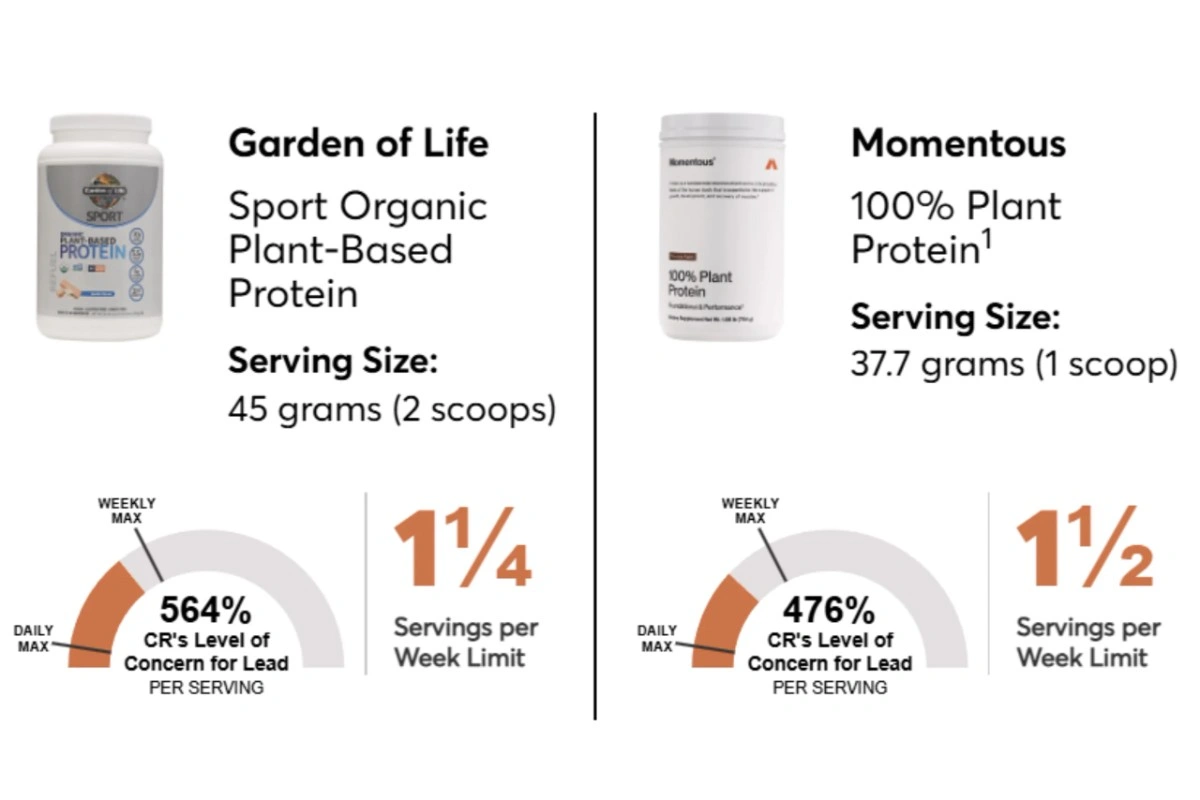
8. PlantFusion Complete Plant Protein
-
Lead level: 1.1 mcg (220% of CR limit)
-
Protein: 21g per scoop
-
CR Recommendation: Once weekly only
9. Transparent Labs Organic Vegan Protein
-
Lead level: 1.3 mcg (260% of CR limit)
-
Protein: 24g per scoop
-
CR Recommendation: Once weekly only
10. Jocko Fuel Vegan Protein
-
Lead level: 1.5 mcg (300% of CR limit)
-
Protein: 20g per scoop
-
CR Recommendation: Once weekly only
🔴 AVOID THESE BRANDS (Consumer Reports Flagged as Dangerous)
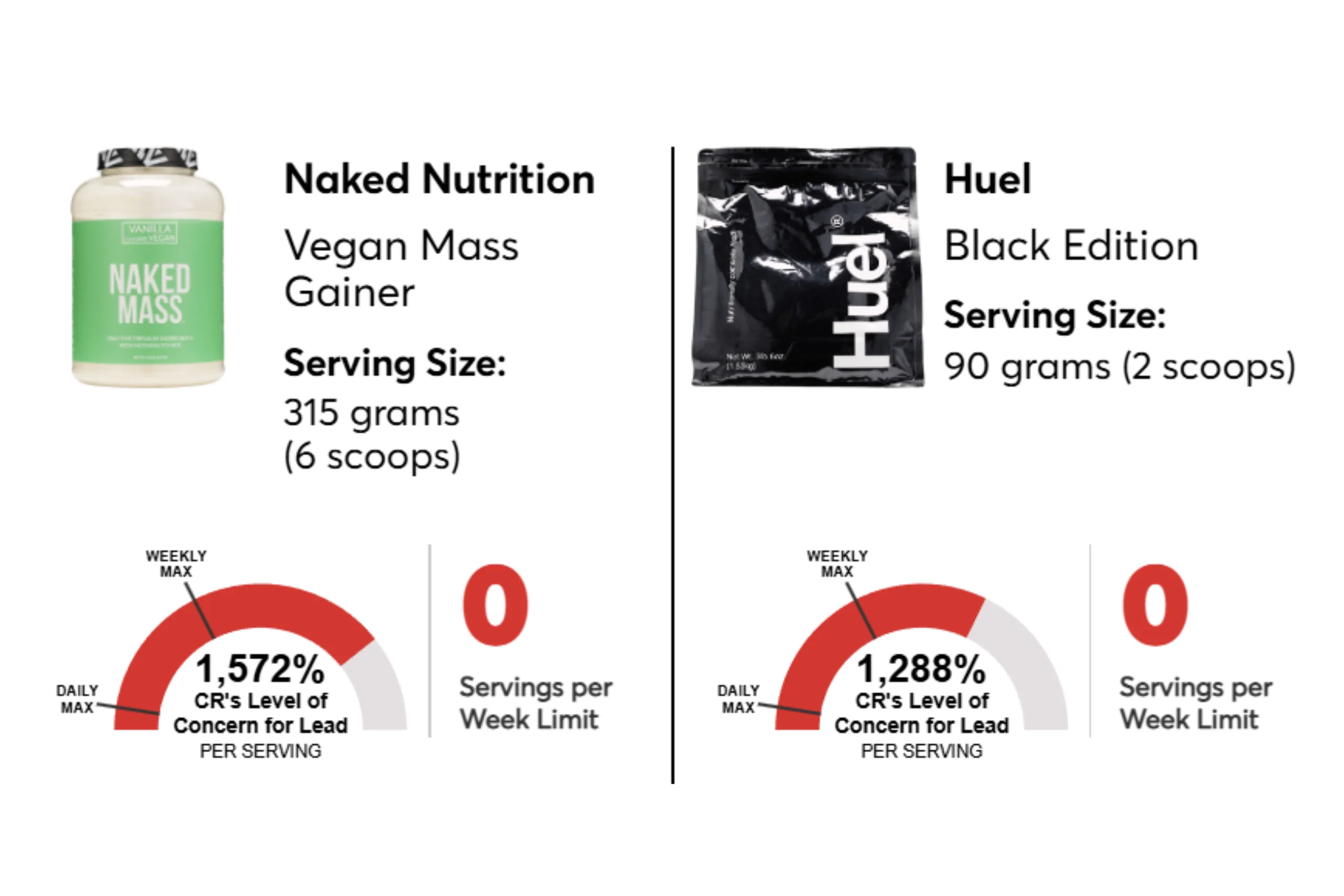
HIGH LEAD – Do Not Use Daily:
❌ Naked Nutrition Mass Gainer
-
Lead level: 7.7 mcg (1,540% over safe limit)
-
CR Recommendation: Do not consume
❌ Huel Black Edition
-
Lead level: 6.3 mcg (1,260% over safe limit)
-
Cadmium: 9.2 mcg (225% over safe limit)
-
CR Recommendation: Do not consume
❌ Garden of Life Sport Organic Plant-Based
-
Lead level: 3.0 mcg (600% over safe limit)
-
CR Recommendation: Once weekly maximum
❌ Momentous 100% Plant Protein
-
Lead level: 2.2 mcg (440% over safe limit)
-
CR Recommendation: Once weekly maximum
❌ MuscleMeds Carnivor Mass (Beef Protein)
-
Lead level: 1.2 mcg (240% over safe limit)
-
CR Recommendation: Occasional use only
❌ Optimum Nutrition Serious Mass (Whey)
-
Lead level: Acceptable
-
Inorganic arsenic: 8.5 mcg (200% over safe limit)
-
CR Recommendation: Occasional use only
❌ Vega Premium Sport
-
Lead level: Acceptable
-
Cadmium: 4.1 mcg (100% of safe daily limit)
-
CR Recommendation: Occasional use only
❌ BSN Syntha-6
-
Lead level: 1.4 mcg (280% over safe limit)
-
CR Recommendation: Occasional use only
Complete Comparison: Safest Protein Powders
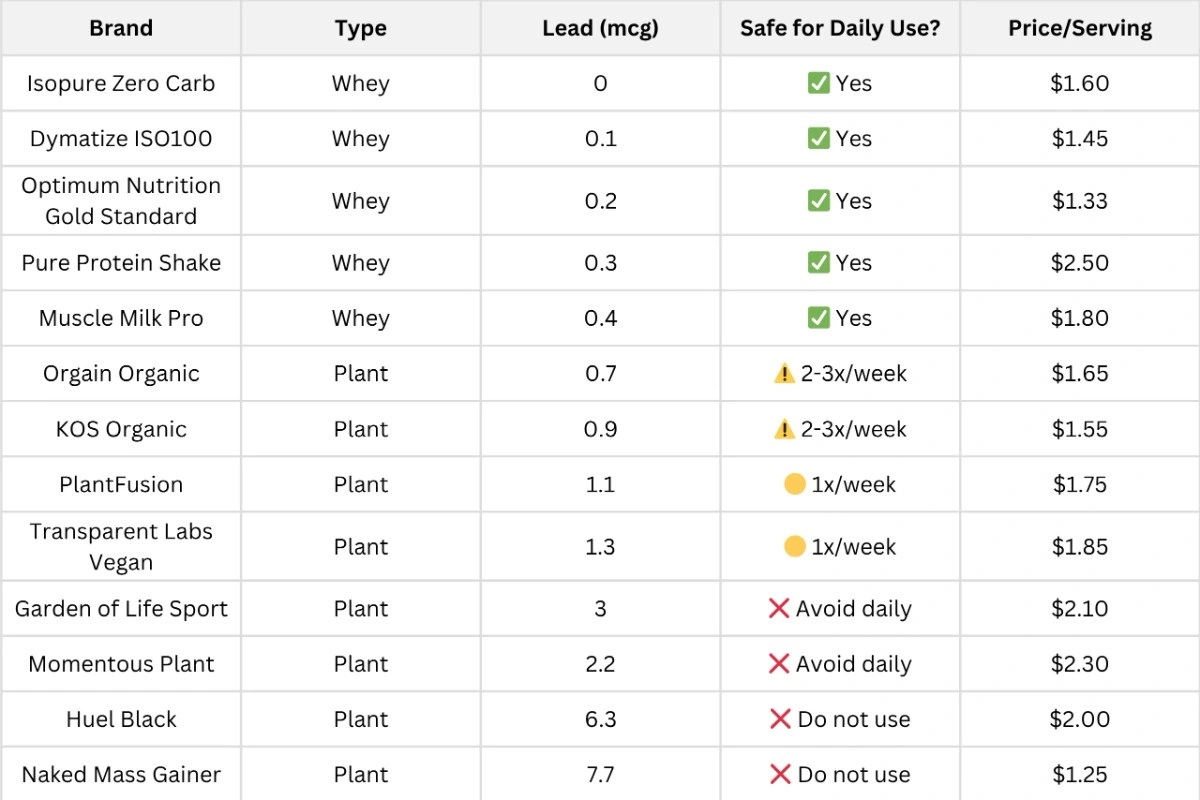
CR Safe Limit: 0.5 mcg lead per serving
Why Whey Protein Is 9X Safer Than Plant Protein
Consumer Reports October 2025 testing revealed dramatic differences between protein sources.
Lead Levels by Protein Type:
Whey/Dairy Protein:
-
Average lead: 0.3 mcg per serving
-
Range: 0.0-0.4 mcg (excluding Serious Mass outlier)
-
Percentage safe for daily use: 83%
Plant Protein:
-
Average lead: 2.7 mcg per serving
-
Range: 0.7-7.7 mcg
-
Percentage safe for daily use: 0%
Beef Protein:
-
Average lead: 1.2 mcg per serving
-
Limited testing (only 2 products)
Plant-based proteins contained 9X more lead than whey-based options.
Why Plant Proteins Have More Lead:
1. Soil Contamination
Plants absorb heavy metals directly from soil through roots. Peas (primary ingredient in plant proteins) grow in contaminated soil from:
-
Industrial pollution runoff
-
Decades of leaded gasoline residue
-
Mining operations
-
Agricultural chemicals
Dairy cows eat grass above soil, creating barrier between contamination source and final protein.
2. China Sourcing
Industry data shows 60-70% of pea protein used in US supplements comes from China, where:
-
Industrial pollution is severe
-
Soil testing standards are lower
-
Heavy metal contamination is widespread
-
Environmental regulations are less strict
Consumer Reports didn’t identify sourcing for each brand, but correlation between plant proteins and high lead suggests sourcing matters.
3. Complex Processing
Extracting protein from peas requires multiple steps:
-
Dehulling (mechanical contamination possible)
-
Grinding into flour (machinery metals)
-
Water separation (water quality matters)
-
Acid treatment (chemical purity)
-
Spray drying (processing equipment)
Each step introduces contamination risk. Whey protein extraction is simpler: milk → separation → drying.
4. Lack of FDA Oversight
FDA doesn’t test supplements before market. Companies self-regulate. Many don’t test for heavy metals despite Consumer Reports findings showing widespread contamination.
For USA shoppers seeking protein powder alternatives alongside other wellness products, our Best Buy Black Friday 2025 deals tracks discounts on blenders, meal prep containers, and kitchen appliances perfect for making protein-rich whole food meals.
Detailed Safe Protein Powder Reviews
1. Isopure Zero Carb – SAFEST OVERALL
Consumer Reports Testing:
-
Lead: Undetectable (0.0 mcg)
-
Cadmium: Undetectable
-
Arsenic: Undetectable
-
CR Rating: Safe for daily use
Product Details:
-
Protein: 25g per scoop (50g serving)
-
Calories: 100
-
Carbs: 0g (zero carb formula)
-
Fat: 0g
-
Source: 100% Whey Protein Isolate
-
Flavors: 12 options
-
Price: $47.99 for 30 servings ($1.60/serving)
Why It’s Safest:
Isopure Zero Carb was the ONLY protein powder Consumer Reports tested with completely undetectable lead levels. As a whey isolate (most refined form of whey), it undergoes additional filtration removing impurities including heavy metals.
Pros:
-
✅ Zero detectable lead (safest tested)
-
✅ Zero carbs (ideal for keto/low-carb)
-
✅ Zero sugar
-
✅ 25g high-quality protein
-
✅ NSF Certified for Sport
-
✅ Mixes easily without clumps
-
✅ Available at major retailers
Cons:
-
❌ Higher price ($1.60 vs $1.33 for Optimum Nutrition)
-
❌ Not suitable for vegans/lactose intolerant
-
❌ Some flavors have artificial taste
Best For:
-
Daily users prioritizing absolute safety
-
Athletes subject to drug testing (NSF certified)
-
Keto dieters (zero carb)
-
Anyone with digestive issues (isolate easier to digest)
Where to Buy:
-
Amazon: $47.99 (free Prime shipping)
-
Bodybuilding.com: $44.99 (subscribe & save)
-
Vitamin Shoppe: $47.99
-
GNC: $49.99
2. Optimum Nutrition Gold Standard Whey – BEST VALUE
Consumer Reports Testing:
-
Lead: 0.2 mcg (60% below CR safe limit of 0.5 mcg)
-
Cadmium: Undetectable
-
Arsenic: Undetectable
-
CR Rating: Safe for daily use
Product Details:
-
Protein: 24g per scoop (30.4g serving)
-
Calories: 120
-
Carbs: 3g
-
Fat: 1g
-
Source: Whey Protein Isolate + Concentrate + Peptides
-
Flavors: 20+ options
-
Price: $59.99 for 45 servings ($1.33/serving)
Why It’s Best Value:
Optimum Nutrition Gold Standard is the world’s #1 selling protein powder with 35+ years track record. At $1.33 per serving with only 0.2 mcg lead (well below safety limits), it offers best combination of safety, quality, and affordability.
Pros:
-
✅ Extremely low lead (0.2 mcg = 60% below limit)
-
✅ Best price among safe options ($1.33/serving)
-
✅ Trusted brand (35+ years, 20+ billion servings sold)
-
✅ Excellent taste (20+ flavors, highly rated)
-
✅ Mixes instantly
-
✅ Available everywhere (Amazon, Walmart, Costco, GNC)
-
✅ NSF Certified for Sport
-
✅ Contains digestive enzymes
Cons:
-
❌ Not zero carb (3g per serving)
-
❌ Contains soy lecithin (allergen for some)
-
❌ Not suitable for vegans
Best For:
-
Budget-conscious daily users
-
Beginners (trusted, proven product)
-
Athletes (NSF certified)
-
Anyone prioritizing taste + safety balance
Where to Buy:
-
Amazon: $59.99 (5 lb, 45 servings)
-
Costco: $54.99 (members save $5)
-
Walmart: $59.99
-
GNC: $64.99
3. Dymatize ISO100 – FASTEST ABSORBING
Consumer Reports Testing:
-
Lead: 0.1 mcg (80% below CR safe limit)
-
Cadmium: Undetectable
-
Arsenic: Undetectable
-
CR Rating: Safe for daily use
Product Details:
-
Protein: 25g per scoop (32g serving)
-
Calories: 110
-
Carbs: 2g
-
Fat: 0g
-
Source: 100% Hydrolyzed Whey Protein Isolate
-
Flavors: 12 options
-
Price: $65.99 for 46 servings ($1.43/serving)
Why It’s Fast-Absorbing:
Dymatize ISO100 uses hydrolyzed whey isolate—protein pre-broken down into smaller peptides for faster absorption. Ideal for post-workout when rapid protein delivery matters most.
Pros:
-
✅ Second-lowest lead tested (0.1 mcg)
-
✅ Fastest absorption (hydrolyzed)
-
✅ Zero fat
-
✅ Low carb (2g)
-
✅ Informed Choice certified
-
✅ Mixes ultra-smooth
-
✅ Great taste ratings
Cons:
-
❌ Higher price than Gold Standard
-
❌ Slightly sweeter taste (some prefer less sweet)
-
❌ Not suitable for vegans
Best For:
-
Post-workout recovery (fast absorption)
-
Competitive athletes
-
Anyone wanting purest whey protein
-
Those with sensitive stomachs (hydrolyzed easier to digest)
Where to Buy:
-
Amazon: $65.99 (3 lb)
-
Bodybuilding.com: $62.99
-
Vitamin Shoppe: $65.99
4. Orgain Organic Plant Protein – BEST PLANT-BASED
Consumer Reports Testing:
-
Lead: 0.7 mcg (140% of CR safe limit)
-
Cadmium: Below detection
-
Arsenic: Below detection
-
CR Rating: Limit to 2-3 times weekly
Product Details:
-
Protein: 21g per serving (46g scoop)
-
Calories: 150
-
Carbs: 15g
-
Fat: 4g
-
Source: Organic pea, brown rice, chia
-
Flavors: 6 options
-
Price: $29.99 for 18 servings ($1.67/serving)
Why It’s Best Plant Option:
Among plant-based proteins tested, Orgain Organic had the LOWEST lead levels at 0.7 mcg. While this exceeds CR’s daily safe limit, it’s 91% lower than worst plant protein (Naked Nutrition at 7.7 mcg) and safe for occasional use.
Pros:
-
✅ Lowest lead among plant proteins tested
-
✅ USDA Organic certified
-
✅ Vegan, gluten-free, soy-free
-
✅ Contains probiotics (1 billion CFU)
-
✅ No artificial ingredients
-
✅ Good taste for plant protein
-
✅ Available at major retailers
Cons:
-
❌ NOT safe for daily use (0.7 mcg lead = 140% of limit)
-
❌ CR recommends maximum 2-3x weekly
-
❌ Gritty texture (common with plant proteins)
-
❌ Higher carbs (15g)
-
❌ More expensive per serving than whey
Best For:
-
Vegans who need occasional protein boost
-
Those with dairy allergies
-
Environmentally-conscious consumers
-
Post-workout 2-3x weekly (not daily)
Usage Recommendation:
Use maximum 2-3 times weekly. For daily protein needs, prioritize whole plant foods (lentils, tofu, tempeh, beans) which have lower lead concentration than concentrated protein powders.
Where to Buy:
-
Amazon: $29.99 (21 oz, 18 servings)
-
Costco: $26.99 (members save)
-
Whole Foods: $29.99
-
Target: $29.99
What To Do If Your Protein Powder Tested High
Step 1: Don’t Panic (But Do Act)
Consumer Reports emphasizes even highest-lead products won’t cause immediate harm from single use. Lead toxicity requires prolonged exposure over months or years.
Immediate vs Long-Term Risk:
-
Single serving of Naked Nutrition (7.7 mcg lead): No immediate danger
-
Daily use for 6+ months: Concerning cumulative exposure
-
Daily use for 1+ year: Potential health impacts
That said, why continue unnecessary exposure?
Step 2: Check Your Brand
If your protein powder is on AVOID list:
-
Naked Nutrition Mass Gainer (7.7 mcg)
-
Huel Black Edition (6.3 mcg)
-
Garden of Life Sport Organic (3.0 mcg)
-
Momentous 100% Plant Protein (2.2 mcg)
-
MuscleMeds Carnivor Mass (1.2 mcg)
Action: Stop daily use immediately. Occasional use (once weekly) poses minimal risk.
If your brand had 0.5-2.0 mcg lead:
Action: Reduce to 2-3x weekly maximum. Replace other servings with whole food protein or safer powder option.
Step 3: Switch to Safe Alternative
For daily use, choose:
-
Isopure Zero Carb (0.0 mcg lead)
-
Dymatize ISO100 (0.1 mcg)
-
Optimum Nutrition Gold Standard (0.2 mcg)
For plant-based (2-3x weekly):
-
Orgain Organic (0.7 mcg)
-
KOS Organic (0.9 mcg)
Step 4: Request Refund
Many retailers accept returns on supplements even past standard windows given Consumer Reports findings.
Where to try:
-
Amazon: 30-day return standard, but many getting refunds citing safety concerns
-
Costco: Extremely generous return policy, accepts almost anything
-
Walmart: 90-day return on most supplements
-
Vitamin Shoppe: Contact customer service with CR report
Brand responses:
-
Vega: Defending products, offering to discuss concerns
-
Huel: Says testing methodology differs from their results
-
Naked Nutrition: Investigating findings, may issue refunds
-
Garden of Life: Claims products meet safety standards
Step 5: Blood Test Usually Unnecessary
Unless you’ve consumed high-lead protein powder daily for 1+ year, blood testing for lead poisoning is overkill according to physicians Consumer Reports consulted.
When to consider blood test:
-
Daily use of product with >3 mcg lead for 1+ year
-
Pregnancy (extra caution warranted)
-
Children using protein supplements (higher vulnerability)
-
Symptoms of lead toxicity (fatigue, headaches, digestive issues, cognitive problems)
Cost: Blood lead test costs $30-100 without insurance, $0-25 with insurance.
Step 6: Transition to Whole Foods
Average American consumes 155% of recommended protein intake through regular diet alone. Supplements are unnecessary for most people.
High-Protein Whole Foods (No Lead Risk):
Breakfast (30g protein):
-
1 cup Greek yogurt (20g) + 2 eggs (12g)
Lunch (35g protein):
-
6 oz chicken breast (35g)
-
OR 1.5 cups cooked lentils (27g) + 1/4 cup almonds (8g)
Dinner (35g protein):
-
6 oz salmon (34g)
-
OR 1 block extra-firm tofu (20g) + 1 cup quinoa (8g) + 1/2 cup black beans (7g)
Total: 100g protein daily, zero supplements needed
How to Choose Safe Protein Powder Going Forward
1. Prioritize Whey Over Plant-Based
Consumer Reports data conclusively shows whey protein averages 9X less lead than plant-based options.
If you can tolerate dairy: Choose whey, whey isolate, or whey hydrolysate.
If strictly vegan: Understand trade-off. Even “safest” plant proteins (Orgain at 0.7 mcg) exceed CR daily limit. Limit use to 2-3x weekly maximum, rely primarily on whole plant foods.
2. Look for Third-Party Testing Certifications
Certifications that test for heavy metals:
NSF Certified for Sport:
-
Tests for 270+ banned substances
-
Verifies heavy metal limits
-
Lead limit: 10 mcg/serving (higher than CR’s 0.5 mcg but still protective)
-
Brands with NSF: Optimum Nutrition, Dymatize, Isopure
Informed Choice:
-
Independent testing program
-
Tests every batch
-
Verifies label accuracy + contaminants
-
Brands: Dymatize, Muscle Milk
USP Verified:
-
United States Pharmacopeia testing
-
Confirms ingredients, potency, purity
-
Tests for contaminants including heavy metals
-
Fewer protein brands carry this (more common for vitamins)
What to avoid:
Generic “tested for purity” claims without specific certification. These are marketing fluff, not verified safety.
3. Check for Prop 65 Warnings
California’s Proposition 65 requires warning labels on products exceeding maximum allowable dose levels (MADL) for lead and other carcinogens.
For lead: MADL is 0.5 mcg daily (same as CR’s safe limit)
If you see Prop 65 warning on protein powder: That product likely exceeds 0.5 mcg lead. Choose different brand.
Note: Some companies with lead levels just above 0.5 mcg have signed consent decrees allowing them to continue selling without warnings by agreeing to specific contamination limits. Vega has paid $336,000 in such settlements.
4. Source Matters – Ask Questions
Contact manufacturers and ask:
-
Where do you source pea protein? (USA/Canada > China)
-
Where is whey sourced? (New Zealand, Ireland, USA best)
-
Do you test finished products for heavy metals?
-
Can you provide test results?
Only 3 brands Consumer Reports tested publish results:
-
Momentous: Posts on website (products have been reformulated since testing)
-
KOS: Provides upon email request
-
Equip Foods: Provides upon email request
If brand won’t share testing data, consider that red flag.
5. Don’t Trust “Organic” Label
Garden of Life Sport ORGANIC had 600% above CR safe limit. Momentous 100% Plant ORGANIC had 440% above limit.
Why organic doesn’t protect against lead:
-
Lead comes from soil contamination, not pesticides
-
Organic certification addresses farming practices, not heavy metal content
-
Organic soil can be just as contaminated as conventional
What “organic” means: No synthetic pesticides, herbicides, GMOs.
What “organic” does NOT mean: Low heavy metals, safer, cleaner protein.
6. Consider Ready-to-Drink Over Powder
Consumer Reports found ready-to-drink shakes like Pure Protein had lower lead levels (0.3 mcg) than most powders.
Why RTD may be safer:
-
More processing oversight in beverage manufacturing
-
Liquid matrix may dilute concentration
-
Companies producing RTD often have stricter quality control
Trade-off: RTD more expensive ($2.50 per 30g protein vs $1.33 for powder)
Protein Powder Alternatives: Whole Foods
You probably don’t need protein supplements at all. Federal nutrition surveys show Americans exceed recommended protein intake by 55% (men) and 35% (women) through diet alone.
How Much Protein Do You Actually Need?
Federal Guidelines:
-
Average adult: 0.8g per kg body weight (0.36g per lb)
-
For 170 lb person: 61g protein daily
-
Older adults (65+): 1.0-1.3g per kg (0.45-0.59g per lb)
-
Pregnant/nursing: 1.1g per kg (0.50g per lb)
-
Athletes: 1.2-2.0g per kg (0.55-0.91g per lb)
Real-world example:
170 lb moderately active adult needs roughly 75-100g protein daily.
Meeting 100g Protein Through Whole Foods
Daily Meal Plan (100g Protein, Zero Supplements):
Breakfast (30g protein):
-
1 cup plain Greek yogurt (20g protein)
-
2 eggs, scrambled (12g)
-
Total: 32g protein
Snack (8g protein):
-
1/4 cup almonds (8g)
Lunch (35g protein):
-
6 oz grilled chicken breast (35g)
-
OR Vegan: 1.5 cups cooked lentils (27g) + 2 tbsp hemp seeds (6g) + 1/4 cup cashews (5g) = 38g
Snack (6g protein):
-
String cheese (6g)
-
OR Vegan: 2 tbsp peanut butter (8g)
Dinner (35g protein):
-
6 oz salmon fillet (34g)
-
OR Vegan: 1 block extra-firm tofu (20g) + 1 cup cooked quinoa (8g) + 1 cup edamame (18g) = 46g
Daily Total: 110-116g protein
Cost comparison:
-
Protein powder: $1.33/serving (24g) = $5.54 per 100g protein
-
Chicken breast: $3.99/lb (96g protein) = $4.16 per 100g
-
Greek yogurt: $5.00/32oz (80g protein) = $6.25 per 100g
-
Eggs: $4.00/dozen (72g protein) = $5.56 per 100g
-
Lentils: $1.50/lb dry (158g protein) = $0.95 per 100g
Whole foods cost the same or LESS than powder, with ZERO lead exposure risk.
Frequently Asked Questions
Is whey protein powder safe from lead?
Yes, whey-based protein powders had the lowest lead levels in Consumer Reports October 2025 testing. Isopure Zero Carb (undetectable), Dymatize ISO100 (0.1 mcg), and Optimum Nutrition Gold Standard (0.2 mcg) all tested well below CR’s 0.5 mcg safety limit. Choose whey over plant-based for daily use to minimize lead exposure.
Can I still use plant-based protein powder?
Yes, but limit frequency. Orgain Organic (0.7 mcg lead) and KOS Organic (0.9 mcg) are safest plant options for 2-3 times weekly use. Daily use of ANY plant-based protein isn’t recommended based on Consumer Reports findings. All plant proteins tested had elevated lead levels, with average 9X higher than whey proteins.
Should I throw away my protein powder?
If your brand tested above 2.0 mcg lead per serving (400%+ over CR limit), yes. Discard immediately: Naked Nutrition Mass Gainer (7.7 mcg), Huel Black Edition (6.3 mcg), Garden of Life Sport Organic (3.0 mcg), and Momentous Plant Protein (2.2 mcg). These pose real risk with daily use. Try requesting refund from retailer first.
How much lead in protein powder is dangerous?
Consumer Reports sets safe limit at 0.5 micrograms lead per day from all food sources combined. Average American already gets 5.3 mcg lead daily through normal diet. Adding 2-7 mcg from protein powder significantly increases exposure. While single servings won’t cause acute poisoning, cumulative daily exposure over months or years raises health risks including cardiovascular disease, kidney damage, and cognitive decline.
Do I need to see a doctor about lead exposure?
Only if you’ve consumed high-lead protein powder (>2 mcg per serving) daily for 1+ year. Blood testing for lead costs $30-100 and is unnecessary for short-term or occasional use. Simply switching to safer brand is sufficient for most users. Pregnant women, children, and those experiencing unexplained symptoms (fatigue, headaches, digestive issues) should consult physician.
Are organic protein powders safer from lead?
No. “Organic” doesn’t protect against heavy metals. Garden of Life Sport ORGANIC contained 3.0 mcg lead (600% over CR limit). Momentous ORGANIC had 2.2 mcg (440% over limit). Heavy metals come from soil contamination affecting organic and conventional crops equally. Organic certification addresses pesticide use, not heavy metal content.
What about collagen powder and other supplements?
Consumer Reports October 2025 study tested only protein powders and shakes. Collagen supplements weren’t included. However, 2020 Clean Label Project testing found similar heavy metal contamination in collagen, bone broth, and greens powders. Choose supplements with NSF Certified for Sport or Informed Choice certifications verifying heavy metal limits.
Why doesn’t FDA regulate protein powder safety?
Dietary supplements fall under 1994 Dietary Supplement Health and Education Act classifying them as food, not drugs. FDA doesn’t test supplements before they reach market and relies on voluntary compliance and post-market surveillance. There are no federal limits for lead in protein powders. FDA inspected only 600 of 12,000 registered supplement manufacturers in 2024.
Final Verdict: Safest Protein Powder Choices 2025
For Daily Use (Best Safety Profile):
1. Isopure Zero Carb – Undetectable lead, purest option
2. Dymatize ISO100 – 0.1 mcg lead, fast-absorbing
3. Optimum Nutrition Gold Standard – 0.2 mcg lead, best value
For Plant-Based (2-3x Weekly Maximum):
4. Orgain Organic – 0.7 mcg lead, lowest among plant proteins
5. KOS Organic – 0.9 mcg lead, second-safest plant option
Best Overall Strategy:
Skip protein supplements entirely. Average American gets 155% of recommended protein through regular diet. Focus on whole foods:
-
Greek yogurt (20g per cup)
-
Eggs (6g each)
-
Chicken breast (31g per 4 oz)
-
Salmon (34g per 6 oz)
-
Lentils (18g per cup)
-
Tofu (20g per cup)
-
Beans (15g per cup)
If you must use protein powder:
-
✅ Choose whey over plant-based (9X safer)
-
✅ Look for NSF Certified for Sport
-
✅ Avoid daily use even of “safe” options
-
✅ Limit to post-workout only (3-4x weekly)
-
✅ Check for Prop 65 warnings (avoid those products)
-
✅ Request third-party test results from manufacturers
Consumer Reports conclusion: “We advise against daily use for most protein powders, since many have high levels of heavy metals and none are necessary to hit your protein goals.”
We agree. Whole foods first, tested supplements occasionally, and always choose whey over plant-based to minimize lead exposure.
For additional wellness and nutrition product recommendations, explore our complete guides to tech deals and safe shopping at major retailers this fall season.


